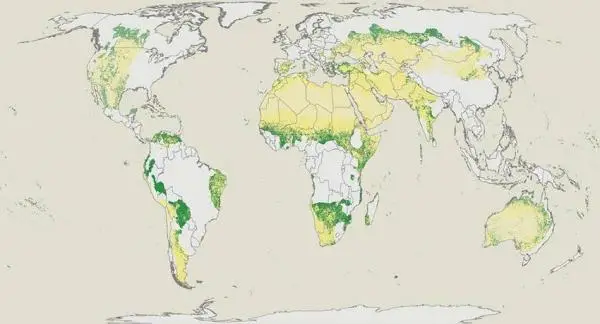After this new study, we must also talk about a new forest atlas and it answers the question of how many trees are there in the world. and fortunately, there are more trees than previously thought, a total of 1,327 million hectares. Thanks to new counting techniques that use technologies that allow the planet to be tracked from satellites The figure, re-estimated by a study published in the journal Science, raises the planet’s wooded area by 9 percent and the existing one by almost 50 percent in the arid lands.
New technologies that allow fine tuning
The study, carried out by the Food and Agriculture Organization of the United Nations (FAO), has had the participation of more than two hundred researchers from different organizations.
The large and qualified participation being important, what is really distinctive has been the possibility of having the aforementioned high-resolution images, collected by satellites of the DigitalGlobe company, used by Google Maps, among other search engines.
This new technology marks a before and after for our purpose, since it has sensors that have a resolution of 25 centimeters, greatly facilitating analysis. Or, more properly said, making it possible with the use of Collect Earth. A hitherto unprecedented opportunity, which FAO has not hesitated to take advantage of.

What is Collect Earth?
Collect Earth is a tool that allows you to collect data through Google Earth, in order to then be able to analyze high-resolution satellite images for different purposes. This is how it has been possible to collect specific data, this time conducting regional forest inventories on lands that have been poorly inventoried up to now.
Specifically, arid lands, with the intention of improving the understanding of the elements present in them in order to deepen the knowledge of the resources that are available as well as to know what environmental protection needs exist.
The “Global Dryland Assessment” is actually a larger project, which also includes counting grasslands in drylands, using an assessment using Collect Earth to analyze more than 200,000 parcels around the world.
The objective of carrying out a global forest cover count (including forests, trees, and grasslands) is achieved with a series of specific methodologies developed by FAO. As the study concludes, in 2015 there were 1,327 million hectares of arid climate biomes with a percentage of forest cover greater than 10 percent.
This data is important because it is the threshold used by FAO to use the forest name in an area of 5,000 square meters. But the main finding is the redefinition of the drylands forest map. In the words of Elena María Abraham, co-author of the study:
The important thing is that by identifying a larger area of dry forest, we are redrawing the map of arid lands. Faced with a scenario of climate change and desertification, in which arid lands are going to expand, it is essential to know the dry forests, the most important resource we have.
Finally, the FAO has carried out this analysis within the framework of two complementary projects of the same organization, such as “Action Against Desertification” and “Global Forest Survey”, in whose implementation the It has the collaboration of a network of governments, NGOs and academic institutions, among other collaborators.
Or, what is the same, beyond the good news of having a larger forest mass, the study has a practical purpose that seeks development in regions that, in general, have scarce resources.

Conclusions
Until now, they had ignored a tree that as a whole would occupy 467 million hectares or, what is the same, as many trees as those that make up the Amazon rainforest. With this, the global tree cover amounts to 1,327 million hectares.
This update has been possible using high-resolution aerial images that improve the results offered by satellites such as Sentinel or Landsat. Above all, it has been refined when counting in arid regions, where trees do not form forests that are easy to translate into trees and, in short, in a certain wooded area, measured in hectares.
In contrast, dry areas have the most scattered trees. As they are not continuous green areas, the count is more complicated. And, according to the new data, the numbers were seriously underestimated.
If we also take into account that almost half of the earth’s surface is characterized by this aridity, we have that the fewer trees found in this large space (specifically 41.5 percent of it) end up adding a good number.
Although it was possible to have an idea of this deficiency at the time of counting, there was not the necessary technology to remedy it and, therefore, the environmental implications that this entailed could not be known in a concrete way.
Now, things have changed and the arid regions have been reviewed, counting the trees that were previously outside. This is the largest review of these arid regions to date for this purpose.
“Using very high-resolution images now means that each pixel of the satellite image can be much more specific and better detect the amount of forest”, explains Javier Gódar, a researcher at the Stockholm Environmental Institute (SEI), who also makes Emphasize the importance of continuing to apply this technology for monitoring that enables follow-up. In this way, logically, more reliable data could be obtained from both deforestation and deforestation processes in these forgotten areas.

